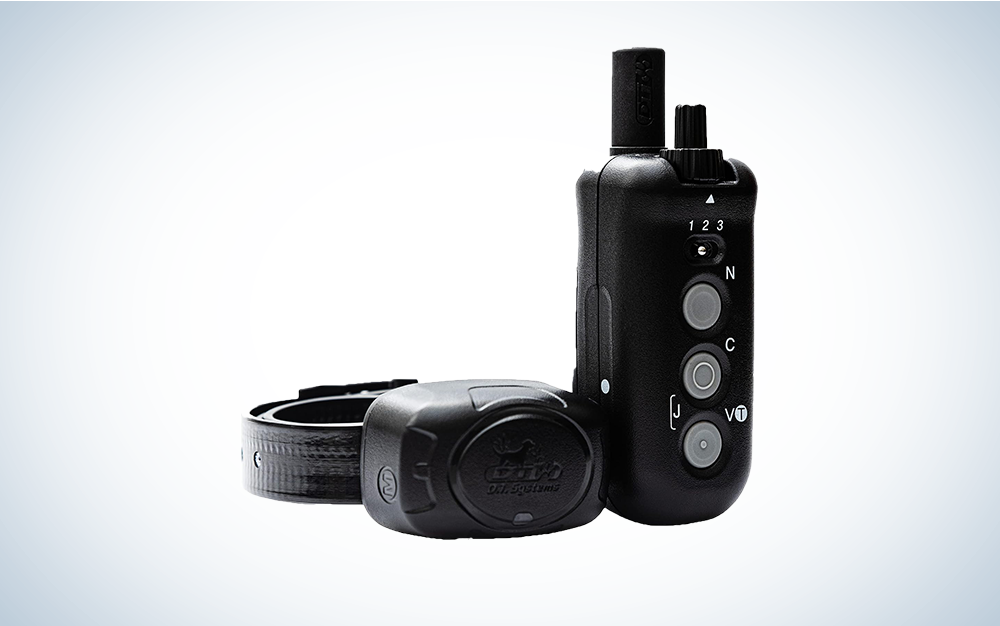A young waterfowling friend recently got a German shorthair and asked me what kind of upland shotgun he should buy so he could take his dog hunting. I said, “That’s the wrong question. You’ve already got a shotgun. Buy a GPS collar first and save up for a bird gun later.”
Yes, that is me, a shotgun columnist telling someone an e-collar is more important than your choice of guns. It’s not just the GPS models that have changed dog training forever, it’s all e-collars. Collars offer instant, long-distance correction. You can’t explain to a dog after the fact what it has done right or wrong, and an e-collar lets you correct the dog in the act. Used correctly, e-collars are invaluable training aids. Bark collars and invisible fences make your dog a better citizen. And beeper and GPS collars let you keep track of your dog in the field.
Here are the best dog training collars to get your pup ready for hunting season.
Best No-Frills GPS: Garmin Pro 550 Plus
Best Invisible Fence: PetSafe Stay and Play Invisible Fence
Best Retreiver Collar: Sportdog 1825X Wetland Hunter
Best Beeper/Trainer: DT 1850 Plus Remote Beeper Trainer
Best Budget Collar: DT Systems DD70
Best Do-Everything Collar: Garmin Alpha 300i
Best Bark Collar: Dogtra YS600 No Bark Collar

| The author’s two German shorthair pointers—Zeke on the left and the late Jed on the right—pose for a picture after a successful hunt. Phil Bourjaily |
How We Picked the Best Dog Training Collars
Since I got my first bird dog in the mid-80s, I have been running dogs with e-collars. I’ve used them to train dogs, handle them in the field, and break them from behaviors like getting up on counters or chasing deer. I used some of the earliest beeper collars and have recently made the switch to GPS locators. I have also been afield with lots of other hunters and had a chance to see their collars in action.
Having started using collars years ago in their dark ages, I have come to appreciate the reliability of contemporary collars. Some, however, are more reliable than others, and I factored that into my choices. User-friendliness matters a great deal, too. If you’re using collars in the field, you’ve got a gun in one hand and a transmitter in the other. Controls have to be easy to find and intuitive.
Collars come in a wide price range, from a couple of hundred dollars to a thousand in the case of GPS systems in which the handheld is essentially a small computer. So, while some of these collars are expensive, I chose units that were, in my opinion, good collars at their price point.
Finally, collars have to hold up to hard use. Transmitters stay fairly safe on your person, but they get bumped and banged around. Collars have to withstand mud, snow, ice, water, grass seeds, brush, and anything else your dog gets into.
Best Dog Training Collars: Reviews & Recommendations
Best No-Frills GPS: Garmin Pro 550 Plus
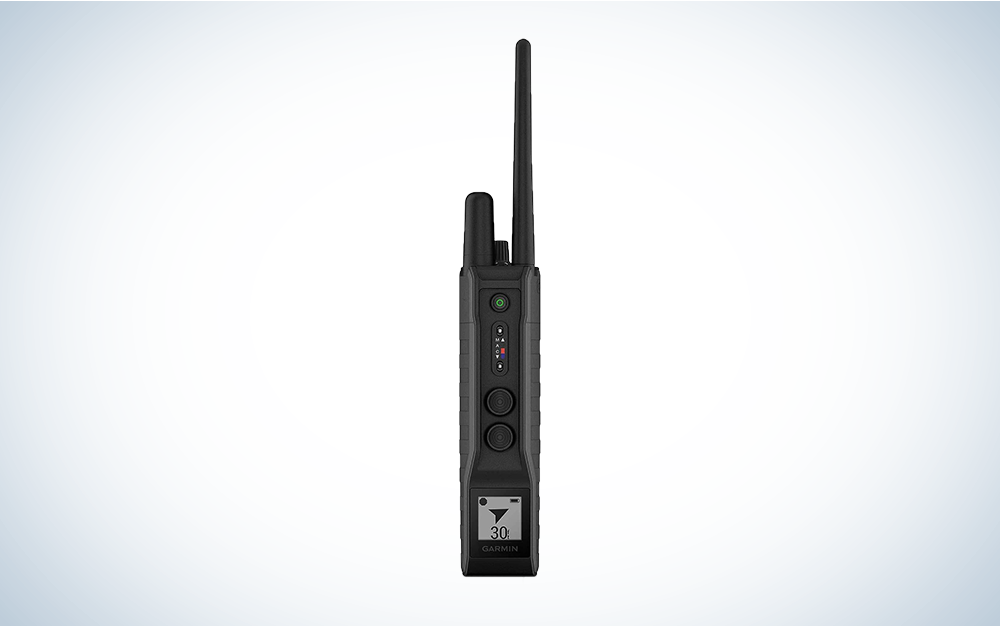
Specs
Use: Location and training
Number of dogs: 3, collars sold separately
Range: 9 miles
Pros
Bare bones display
Eighteen stimulation levels
Simple controls
Cons
Transmitter is bulky
The Pro 550 Plus is the name of a transmitter unit only. It can be paired with any Garmin collar or bought in a bundle. It doesn’t tell me where my truck is, nor can it show me where I found quail last week. There are other, more fully-featured collars for that. But the Pro 550 Plus tells me where my dog is up to a distance of nine miles. It buzzes if he’s on point, and it lets me correct him if I have to. The transmitter unit is long and a little bulky, with rubber armor and a small screen at the bottom. It has momentary, tone, and continuous buttons, and offers 18 levels of stimulation as well as tone and vibrate. The transmitter can control up to three collars at once. It gives me everything I need in a collar and nothing I don’t.
The display is brilliantly simple, black on gray, and easy to see. A triangular arrow points in your dog’s direction, and it tells you how many yards away it is. When you get close to a dog buried on point in heavy cover, it shows the distance in feet. When you’re far away, it shows you the distance in miles, but Zeke never gets that far away. The unit’s only drawback is that the transmitter is on the large side compared to many other e-collar transmitters available.

| The Garmin Pro 550 Plus will track your dog up to nine miles and buzz you if the dog goes on point. Garmin |
Best Invisible Fence: PetSafe Stay and Play Invisible Fence
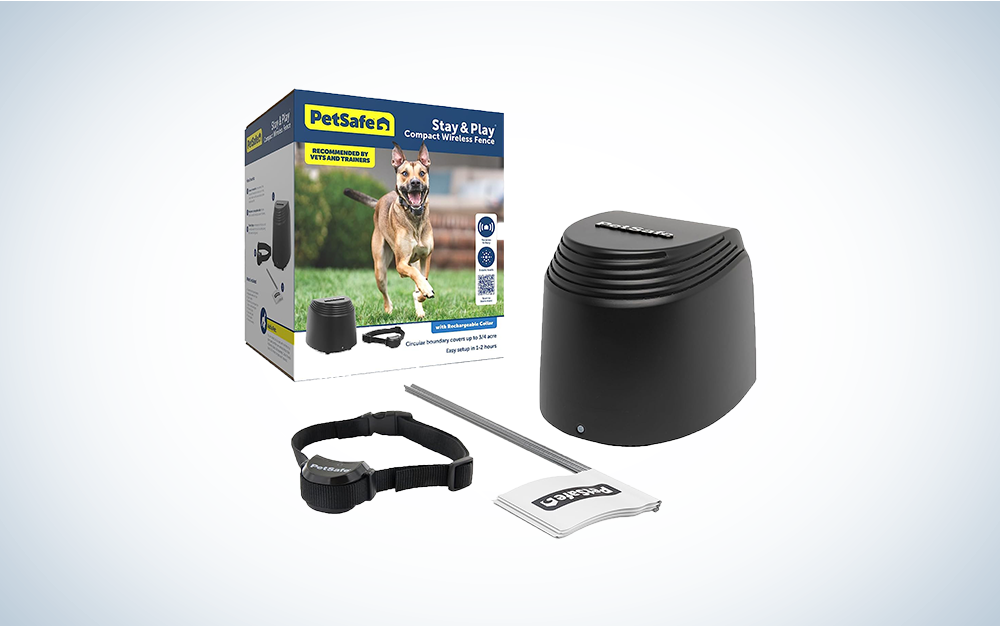
Specs
Range: ¾ acre circle
Uses: Keeps dog from leaving a safe area
Number of dogs that can be trained: Unlimited with add-on collars
Pros
No digging is required to install an invisible fence
Correction-free re-entry if the dog does leave
Portable
Cons
Only protects a circular area—cannot be configured to other shapes
The Stay Safe Wireless Rechargeable Fence keeps your dog inside a designated 3/4-acre play area with no need to dig and bury wires as with many other “invisible fence” type units. This unit consists of a stationary transmitter and a collar. The transmitter can be set up indoors, where it plugs into an outlet on the ground floor. It broadcasts over a maximum ¾- mile circular area, which can be reduced to accommodate smaller yards. The collar sounds a warning tone as your dog approaches the boundary. Crossing the boundary triggers one of five stimulation levels in the collar. Should your dog get through the barrier, it won’t correct on the way back inside the circle. The unit also comes with flags you can use to mark the perimeter for training.
You can add as many collars as needed, in case you have a whole pack to contain, and you can also add a second transmitter to control an overlapping figure-8 area. And, because there are no wires to bury, you can take the unit with you on vacation to a cabin or campsite and establish a secure play area there. The only true downside of the Wireless Rechargeable Fence is that you can’t set it up to accommodate any shape other than a circle.
Best Retreiver Collar: Sportdog 1825X Wetland Hunter
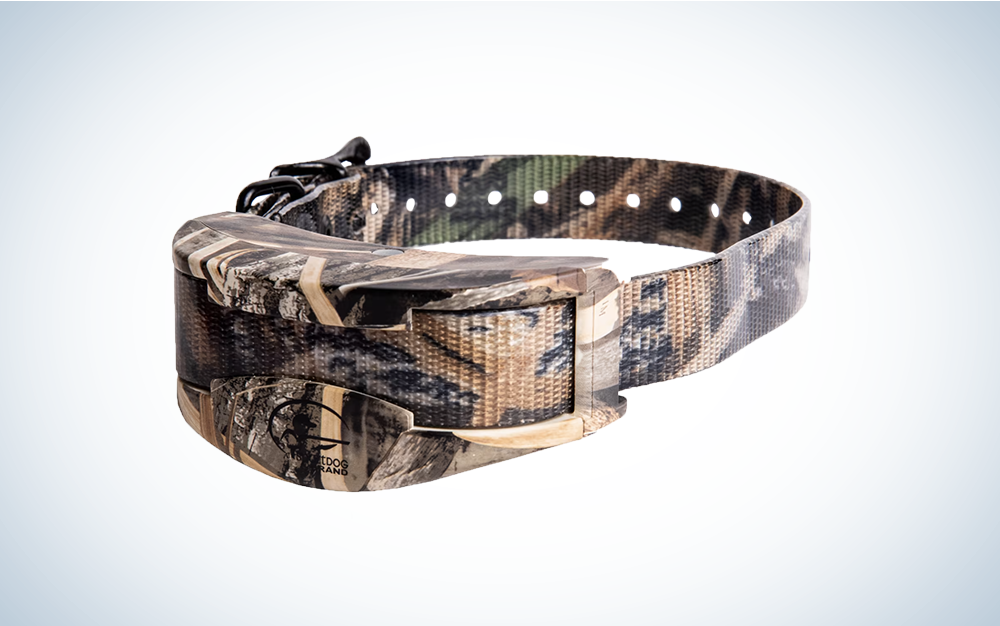
Specs
Use: Waterfowling, all-around training
Range: 1 mile
Number of dogs: Up to 6, with extra collars added
Pros
Compact
Camo finish
Simple
Cons
Only continuous stimulation, no momentary or “nick” setting
Waterfowling can be dangerous for a retriever. A dog with a lot of drive can get itself into trouble if you can’t call it off a long swim in rough water, or keep it under control around all the guns. You need a collar that’s completely waterproof, reliable, and compact, because you already have a lot of gear to keep track of. The SportDog 1825X is the answer, and it even comes in a camo version just to fit into the blind a little better.
The unit has a one-mile range, which is modest by some standards but more than enough for waterfowling use. It has a toggle switch to allow you to control up to six dogs at once (no one hunts with six dogs, but it could be useful in off-season training). A dial lets you choose among seven stimulation levels plus Vibrate and Tone. It also has three stimulation buttons—low, medium, and high—increasing the number of settings to 21 and allowing you to instantly choose a gentle, medium, or urgent correction by pushing different buttons. All three levels are continuous, meaning they deliver stimulation as long as you hold the button down. The collar does lack the “momentary” or “nick” feature found on some other collars. That’s about the only downside to a camo collar that is waterproof to 25 feet and will allow you to train and hunt your water dog more efficiently.
Best Beeper/Trainer: DT 1850 Plus Remote Beeper Trainer
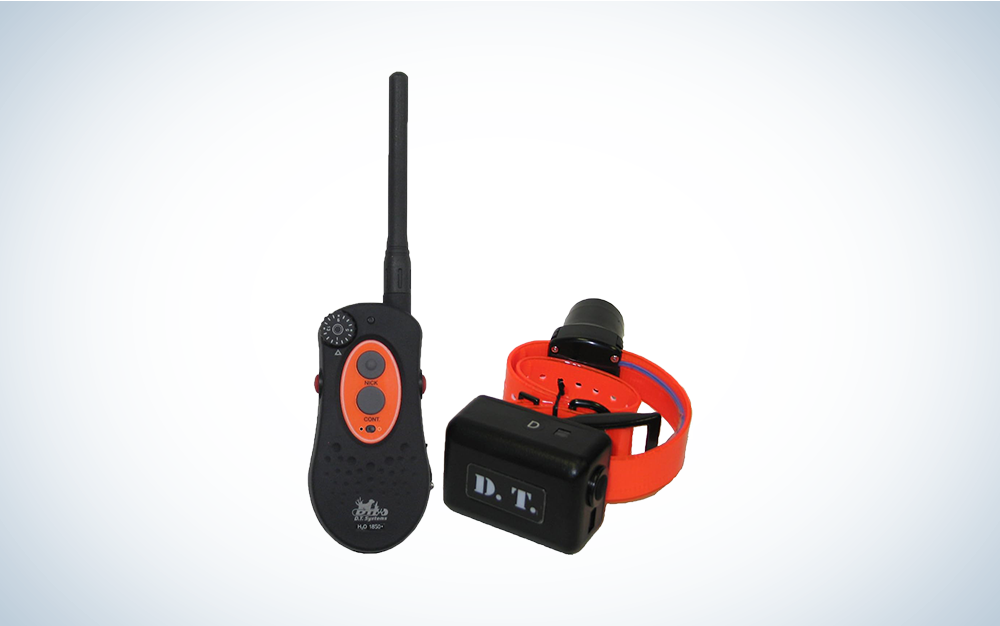
Specs
Use: Training and locating dogs in the field
Range: 1 mile
Dogs trained: 2, with accessory collar
Pros
Allows you to locate dogs less expensively than with GPS
Locate mode lets you hunt in silence and only use the beep when you need it
Cons
Rubber charging port cover can tear off
The beeper collar fits in between a simple bell and a GPS. Unlike a bell, it doesn’t clog with snow, and it doesn’t stop when the dog is on point and you need to find it. Instead, it switches sounds so you know it’s pointing. Beepers are great for keeping tabs on close-ranging dogs if you can stand listening to a beep that sounds like a truck backing up throughout your hunt. And, you can run it on “point-only” mode, or even run it on point-only and combine it with a bell. When you hunt with a beeper, everyone in the party knows where the dog is, both for safety and to keep everyone involved in the hunt.
Before I switched to a GPS, I used an 1850 Plus for several seasons. It always worked, which I expect from collars now, but it’s always good to know. Along with the usual “run,” “run and point,” and “point-only” modes, it has a “locate” button that lets you run your dog in silence, but also find it with a push of the button that sounds off a beep. You can toggle back and forth between two dogs if you want to add a collar. The training part of the collar has sixteen levels of stimulation. While it has no “vibrate” or “tone,” the lowest setting gives very mild stimulation.
I liked the collar very much and only stopped using it because I prefer a GPS. The only problem I ever had with it was that the rubber cover for the charging port on the collar tore off, so I had to clean it out before I could charge it.
Best Budget Collar: DT Systems DD70

Specs
Use: Training, close-range hunting
Range: 700 yards
Dogs Trained: Up to three dogs with accessory collars
Pros
High quality for its price
Comfortable, intuitive transmitter
Enough range for many hunting situations
Cons
Requires 9-volt battery
Electronic collars don’t have to cost several hundred dollars. The DD700 sacrifices long-range and a few other features too, in return for a price point well below $200. It’s intended for obedience and yard work, but its 700-yard range is long enough for anyone who hunts brushy cover, woods, or tall grass where you can’t come close to even seeing 700 yards. Although the distance may decrease if you are in timber or hilly terrain.
The collar comes with tone, vibrate and ten stimulation settings in both “nick” and continuous. The transmitter offers a programmable “jump” setting so you can deliver great levels of stimulation without using the power knob. It’s a very useful feature if you have to stop a dog right away, say, to keep it off a busy road or call it off a deer or some other animal you don’t want it to chase. In these days of rechargeable batteries, a transmitter that operates off a conventional 9-volt might seem like a drawback, but they are easy to change and last a long time.
Best Do-Everything Collar: Garmin Alpha 300i
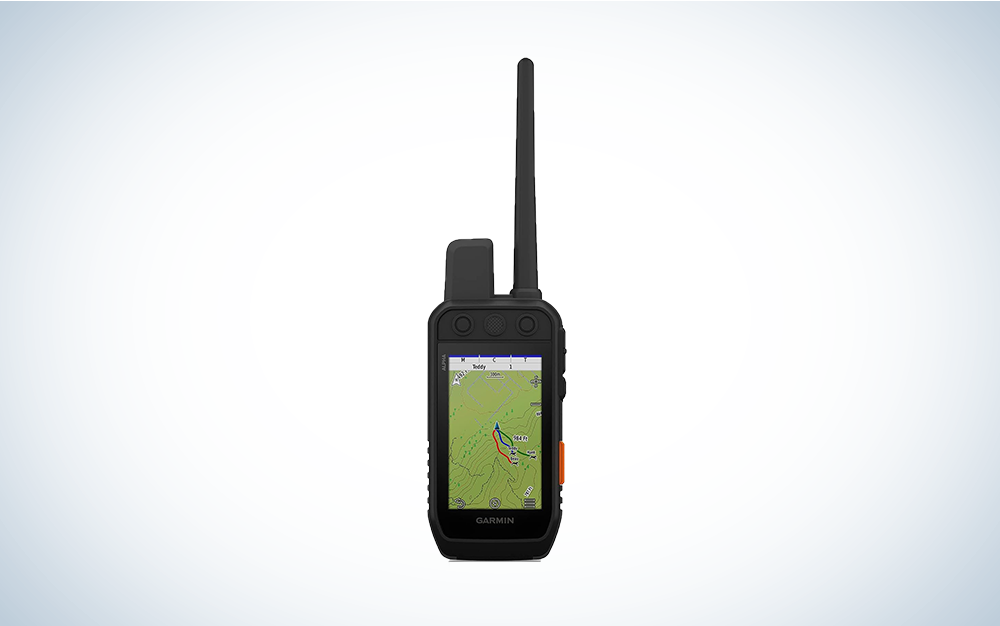
Specs
Uses: Training, tracking, navigation, emergency messaging
Range: 9 miles
Dogs trained: Up to 20, collars sold separately
Pros
Combines training, tracking, nav, and emergency messaging in one unit
Long battery life
Bright screen
Cons
Expensive, some features require a subscription
If you’re a tech-inclined hunter who gets way off the beaten path, you’ll find the Garmin 300i is well worth its considerable price tag. It might even be a literal lifesaver. The 300i’s impressive capabilities let it track up to 20 dogs at once, at ranges up to nine miles. You can see where each dog is, and keep tabs on how long it’s been down and how far it has run. It also displays the dog’s track, as well as topo maps, altitude gain, and maps showing boundaries and landowners. It can store up to 10,000 pins, and remember 250 dogs. And, crucially for those who get far off the road, it includes Garmin’s InReach, which allows you to send and receive texts and SOS signals from anywhere.
With tone, vibrate, and 18 levels of stimulation, you can scroll through the members of your pack and make corrections. The 300i has convenient hard buttons on the sides to control stimulation, which I find preferable to using a touch screen. All in all, the 300i contains a dizzying number of features packed into a unit that weighs 10 ounces and fits in the palm of your hand. For the hunter who just wants to know where their dog is, the 300i is overkill, but for the hardcore dog person willing to explore all its features (and pay some messaging, SOS, and mapping subscriptions), the 300i is a tool like no other.
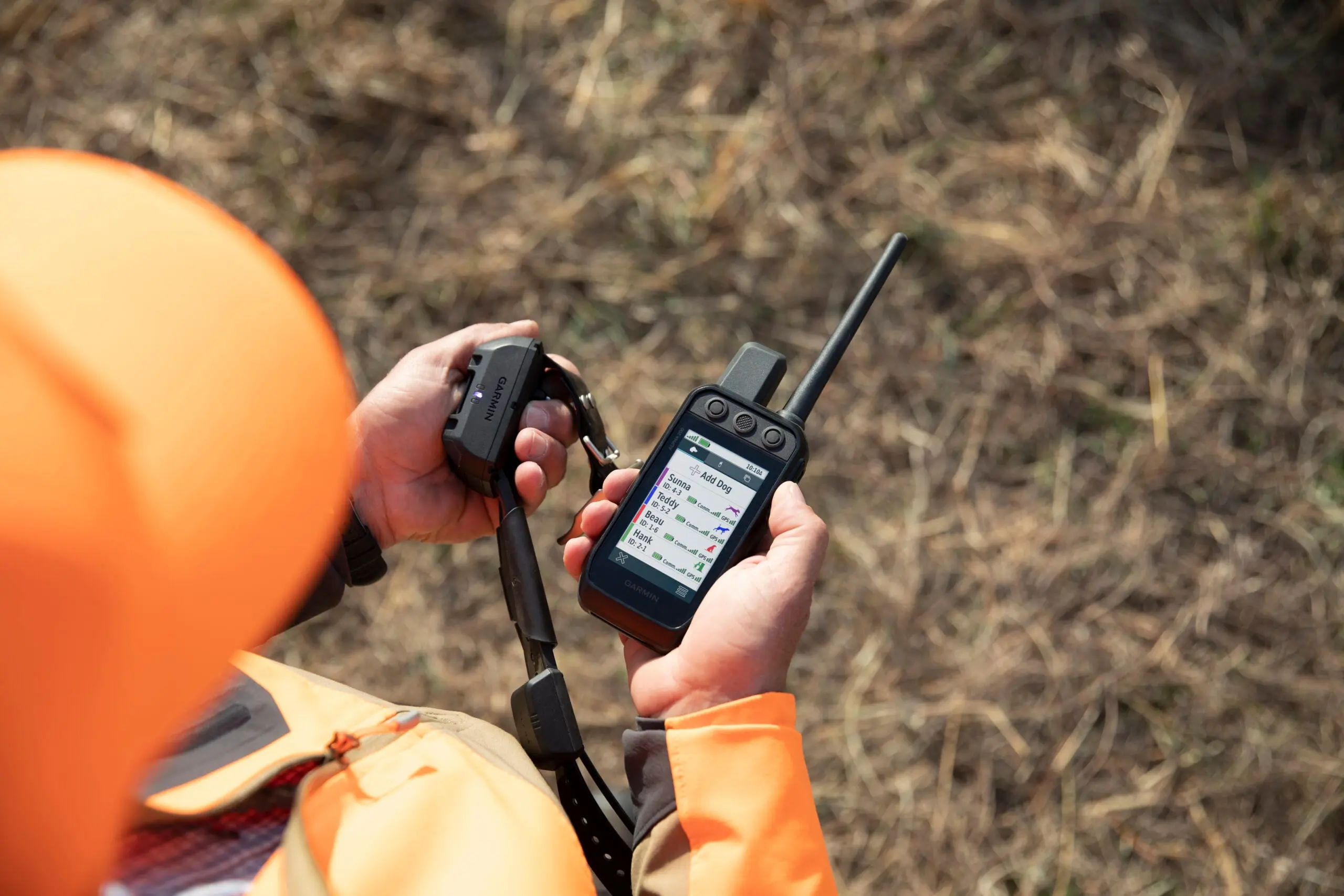
| The Garmin Alpha 300i can track up to 20 dogs and store up to 10,000 pins. Garmin |
Best Bark Collar: Dogtra YS600 No Bark Collar

Use Curtail barking
Range: N/A, works on dogs wearing it
Dogs trained: 1
Pros
Vibrates before stimulation for humane training
Good controls
Cons
Not for use with dogs smaller than 35 pounds
Barking dogs annoy you and really annoy the neighbors. While some people have success solving barking problems by spraying the barking dog with a garden hose in the act, the best way is with a collar. It makes instant corrections, and it doesn’t require your immediate presence. Dogtra’s YS 600 Stubborn Dog No-Bark Collar is a great tool for the job. The collar features both a vibrating function and ten levels of stimulation. And, the YS 600 vibrates before it gives stimulation. The dog quickly learns to associate the vibration with the coming stimulation, and most dogs will stop barking to avoid the stim.
From there, you can move to a painless “vibration only” setting. The collar’s dial is easy to turn, allowing you to choose among settings. It also includes a “test” setting as well as a persistent bark feature that tells you if the dog has been barking while the collar was off, say, if it were insufficiently charged. All of these features packed into the YS600 make it a very good value at under $100. And, if you have ever put up with a dog that barks non-stop, you know that’s a cheap price to pay to help it quiet down.

| The author’s shorthair, Zeke, points to a pheasant in the brush. Phil Bourjaily |
Things to Consider Before Buying a Dog Training Collar
Some people believe collars are cruel. I would disagree, so long as you use the collar correctly. What is cruel is confusing dogs and disciplining them when they don’t understand why. And, although “shock collar” was the old term for e-collars, most have a wide range of stimulation levels that let you use the mildest level that works. Many have tone and vibrate functions, too. For around-the-house and leash-manner training, I don’t have to use any more stimulation on Zeke, my German shorthair, than a brief, painless vibration of the collar. I strap a GPS collar on Zeke during every hunt, so I know where he is and whether he’s on point. Mine has a nine-mile range, so I could use it to find him if he ever got lost in the field.
There are electronic collars for all purposes, from units best for yard work to sophisticated GPS models that combine mapping and navigation with training. Think hard about what you need. How many dogs do you need to train? How much range do you need? What extra capabilities besides training do you need? A hunter who follows bird dogs in thick cover needs to know where their dog is. A waterfowler usually doesn’t, so there is no need for a GPS if you only hunt ducks. A collar with too many features can be almost as bad as one that doesn’t offer enough. Choose a collar from a reputable maker, and recognize that cutting corners on a collar purchase will leave you more frustrated, not less, defeating one of the main purposes of an electronic trainer in the first place.
FAQs
Q: Are e-collars cruel?
E-collars work by delivering electronic stimulation to a dog. Misused, they can be inhumane. Used properly, e-collars are an invaluable means of long-distance communication, allowing you to correct a dog immediately in such a way that it leans after only a few stimulations. In most situations, you can train with very low levels of stimulation, or use a tone first, then stim, so that the dog quickly learns to obey upon hearing the tone. In other cases, merely using the “vibrate” setting is enough. At the other end of the spectrum, a collar set at a high level can break a dog from dangerous behaviors like running deer or approaching rattlesnakes with only a few, or even one, repetition.
Q: Do dogs become collar-shy?
Dogs understand cause and effect, and once they learn that wearing the collar means they will receive stimulation, they come to associate collars with correction. Some people put dummy collars on dogs to wear to get them accustomed to the collar so they don’t learn to link the collar with correction. Be consistent, and be aware that while we are smarter than dogs, they are very observant of causes and effects.
Q: Can you use an e-collar in the house?
Yes, an e-collar can be useful in the house for eliminating behaviors like getting up on counters or rummaging in the garbage. You can either train the dog to obey the command “get down” or whatever, or you can stay silent and deliver stimulation so the dog learns to associate the counter with an unpleasant feeling.
Best Dog Training Collars: Final Thoughts
Best No-Frills GPS: Garmin Pro 550 Plus
Best Invisible Fence: PetSafe Stay and Play Invisible Fence
Best Retreiver Collar: Sportdog 1825X Wetland Hunter
Best Beeper/Trainer: DT 1850 Plus Remote Beeper Trainer
Best Budget Collar: DT Systems DD70
Best Do-Everything Collar: Garmin Alpha 300i
Best Bark Collar: Dogtra YS600 No Bark Collar
Picking the right electronic collar for your needs and using it humanely removes a lot of frustration in dog ownership. You will come to depend on an e-collar, so it’s important that you buy one that will hold up and give you trouble-free service. It’s also important that you choose a collar with sufficient range for your dog. Study the list above and find the collar with the features that make sense for you. An e-collar is one of the most important pieces of gear you will buy, so choose carefully.
Why Trust Us
For more than 125 years, Field & Stream has been providing readers with honest and authentic coverage of outdoor gear. Our writers and editors eat, sleep, and breathe the outdoors, and that passion comes through in our product reviews. You can count on F&S to keep you up to date on the best new gear. And when we write about a product—whether it’s a bass lure or a backpack—we cover the good and the bad, so you know exactly what to expect before you decide to make a purchase.




